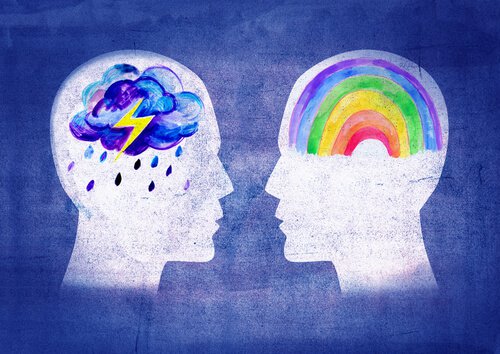How Feelings Influence Decision-Making

Surely you’re not surprised that feelings influence decision-making. How many times have you regretted making a decision in a particular emotional state? You’ve probably noticed that you are more prone to take risks when you feel happy, while sorrow causes the opposite effect.
Making decisions when we are angry is not usually successful, nor when we are in a state of euphoria. But do you really know how your feelings affect your decisions? Have you ever been carried away by the first impression to decide? Are you aware of how your emotions are manipulated to “help” make decisions “?
“The great value of knowing how to give ourselves is that each and every one of the feelings can quit anytime and anywhere in an instant, and can be done continuously and effortlessly”
-David R. Hawkins-
Heuristic affection and decision making
Heuristic affection is a mental shortcut that allows people to make decisions and solve problems quickly and efficiently. It also means that emotions (fear, pleasure, surprise, etc.) play a major role in decision-making.
It is a process that operates below consciousness and shortens the time of decision making, enabling people to function without having to constantly search their brains for relevant information. This approach quickly and unintentionally occurs in response to a stimulus.

Heuristic affection usually comes as we judge the risks and benefits of something, depending on the positive or negative feelings we associate with a stimulus. It is equivalent to acting based on what your heart tells you.
Researchers have found that if your feelings toward something are positive, then it is more likely that you will undervalue risks and overestimate the benefits. Whereas if your feelings for an activity are negative you will be more likely to overestimate the risks and underestimate the benefits .
Examples of heuristic affection
To see how the heuristic affect works, we will look at some practical examples. The first example is so obvious that it seems very simple. The second, perhaps not so much.
To begin, imagine a scene in which two children are going to play at a park. One of the children has played on the swings at his grandparents’ home for a long time and since he loves them so much and has had fun with them, he has positive feelings toward the swings in the park. When he sees them, he immediately makes the decision to go to the swings because he believes that he will have fun, despite the risks of falling off the swing (high profit, low risk) and runs towards them.

However, the other child recently fell from a swing while playing elsewhere. This child, when he sees the swings, believes these are a bad choice (little benefit, high risk). Both children have taken a mental shortcut to decide on the advantages and disadvantages of playing on the swings. Neither one has stopped to try to realistically assess the benefits and risks, but rather have made their decision based on a memory.
This seems so simple and so obvious in a child. As adults we also do it in many situations where, if we dedicated a little time to think reflectively, we would make another decision.
In these decisions, heuristics how we perceive advantages and disadvantages. While these mental shortcuts allow people to make quick and often reasonably accurate decisions, it can also lead to poor decision-making.
As an example, think of advertising. In advertising, strategies are used to make you feel good. They arouse your positive emotions and incite your passions or introduce you to a way of life that you identify with or would like to have.
That makes you much more receptive when buying or more willing to pay more for products and services they offer. In fact, it works so well so that we may feel inclined to buy products thinking they cover a need we do not really have. Even not being able to access the object that covers the alleged need can case us anxiety.
Some scientific observations
Research has shown that risks and benefits are negatively correlated in our minds. People make their judgments about an activity or technology not only for what they think about it, but also how they feel about it.
A study in 1978 by Lichtenstein and colleagues shed much light on the important role that the heuristic affection has in decision-making. The researchers found that the judgments of the benefits and risks were negatively correlated.
That is, they found that people undervalue the risk as we have a more optimistic view of the benefits. The same is true the other way around, the greater the risks the fewer potential benefits.

Certain behaviors, such as alcohol consumption and smoking, are assessed as high risk and low profit, while others, such as the use of antibiotics or vaccines, were considered high profit and low risk.
A little later, in 1980, Robert B. Zajonc argued that affective reactions to stimuli are often the first reaction that occurs automatically and subsequently, influences how information is processed and judged.
In 2000, Finucane and others theorized that a positive feeling toward a situation (ie, positive affect) would lead to a lower risk perception and a perception of greater benefit, even though this obviously is not justified in all situations.
Either way, humans are far from being the rational machine that some aspire to be. Whether we like it or not, our mind is prepared and predisposed to make decisions quickly and using only part of the information. In fact, many times we make decisions before we realize that we have made them.
Why Emotions Influence Us More Than Reason?
Emotions tend to prevail over reason. The general cause is that we are more heart than brains. And this can seriously affect our decisions. See more
Surely you’re not surprised that feelings influence decision-making. How many times have you regretted making a decision in a particular emotional state? You’ve probably noticed that you are more prone to take risks when you feel happy, while sorrow causes the opposite effect.
Making decisions when we are angry is not usually successful, nor when we are in a state of euphoria. But do you really know how your feelings affect your decisions? Have you ever been carried away by the first impression to decide? Are you aware of how your emotions are manipulated to “help” make decisions “?
“The great value of knowing how to give ourselves is that each and every one of the feelings can quit anytime and anywhere in an instant, and can be done continuously and effortlessly”
-David R. Hawkins-
Heuristic affection and decision making
Heuristic affection is a mental shortcut that allows people to make decisions and solve problems quickly and efficiently. It also means that emotions (fear, pleasure, surprise, etc.) play a major role in decision-making.
It is a process that operates below consciousness and shortens the time of decision making, enabling people to function without having to constantly search their brains for relevant information. This approach quickly and unintentionally occurs in response to a stimulus.

Heuristic affection usually comes as we judge the risks and benefits of something, depending on the positive or negative feelings we associate with a stimulus. It is equivalent to acting based on what your heart tells you.
Researchers have found that if your feelings toward something are positive, then it is more likely that you will undervalue risks and overestimate the benefits. Whereas if your feelings for an activity are negative you will be more likely to overestimate the risks and underestimate the benefits .
Examples of heuristic affection
To see how the heuristic affect works, we will look at some practical examples. The first example is so obvious that it seems very simple. The second, perhaps not so much.
To begin, imagine a scene in which two children are going to play at a park. One of the children has played on the swings at his grandparents’ home for a long time and since he loves them so much and has had fun with them, he has positive feelings toward the swings in the park. When he sees them, he immediately makes the decision to go to the swings because he believes that he will have fun, despite the risks of falling off the swing (high profit, low risk) and runs towards them.

However, the other child recently fell from a swing while playing elsewhere. This child, when he sees the swings, believes these are a bad choice (little benefit, high risk). Both children have taken a mental shortcut to decide on the advantages and disadvantages of playing on the swings. Neither one has stopped to try to realistically assess the benefits and risks, but rather have made their decision based on a memory.
This seems so simple and so obvious in a child. As adults we also do it in many situations where, if we dedicated a little time to think reflectively, we would make another decision.
In these decisions, heuristics how we perceive advantages and disadvantages. While these mental shortcuts allow people to make quick and often reasonably accurate decisions, it can also lead to poor decision-making.
As an example, think of advertising. In advertising, strategies are used to make you feel good. They arouse your positive emotions and incite your passions or introduce you to a way of life that you identify with or would like to have.
That makes you much more receptive when buying or more willing to pay more for products and services they offer. In fact, it works so well so that we may feel inclined to buy products thinking they cover a need we do not really have. Even not being able to access the object that covers the alleged need can case us anxiety.
Some scientific observations
Research has shown that risks and benefits are negatively correlated in our minds. People make their judgments about an activity or technology not only for what they think about it, but also how they feel about it.
A study in 1978 by Lichtenstein and colleagues shed much light on the important role that the heuristic affection has in decision-making. The researchers found that the judgments of the benefits and risks were negatively correlated.
That is, they found that people undervalue the risk as we have a more optimistic view of the benefits. The same is true the other way around, the greater the risks the fewer potential benefits.

Certain behaviors, such as alcohol consumption and smoking, are assessed as high risk and low profit, while others, such as the use of antibiotics or vaccines, were considered high profit and low risk.
A little later, in 1980, Robert B. Zajonc argued that affective reactions to stimuli are often the first reaction that occurs automatically and subsequently, influences how information is processed and judged.
In 2000, Finucane and others theorized that a positive feeling toward a situation (ie, positive affect) would lead to a lower risk perception and a perception of greater benefit, even though this obviously is not justified in all situations.
Either way, humans are far from being the rational machine that some aspire to be. Whether we like it or not, our mind is prepared and predisposed to make decisions quickly and using only part of the information. In fact, many times we make decisions before we realize that we have made them.
Why Emotions Influence Us More Than Reason?
Emotions tend to prevail over reason. The general cause is that we are more heart than brains. And this can seriously affect our decisions. See more
This text is provided for informational purposes only and does not replace consultation with a professional. If in doubt, consult your specialist.







